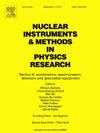用中子共振透射分析定量非均质核燃料球团的不均匀性
IF 1.5
3区 物理与天体物理
Q3 INSTRUMENTS & INSTRUMENTATION
Nuclear Instruments & Methods in Physics Research Section A-accelerators Spectrometers Detectors and Associated Equipment
Pub Date : 2025-04-16
DOI:10.1016/j.nima.2025.170460
引用次数: 0
摘要
掺入可燃毒物的核燃料的不均匀性会对中子参数产生相当大的影响,如作为核燃料燃耗函数的反应性损失。这些不均匀性可以用非破坏性分析技术来识别。在GELINA设施(比利时JRC-Geel)对富集的UO2-Gd2O3燃料球团进行的测量证实,中子共振透射分析(NRTA)可以是一种无损检测方法,适用于研究非均质材料和突出烧结球团中几十微米尺度上的非均质性。利用蒙特卡罗模型,利用Doub提出的解析粒子自屏蔽校正因子对NRTA的性能进行了研究。本文章由计算机程序翻译,如有差异,请以英文原文为准。
Quantifying inhomogneities in heterogeneous nuclear fuel pellets by neutron resonance transmission analysis
Inhomogeneities in nuclear fuel in which burnable poison are incorporated can induce sizeable effects on neutronic parameters such as the reactivity loss as a function of nuclear fuel burnup. These inhomogeneities can be identified using non-destructive analysis techniques. Measurements carried out at the GELINA facility (JRC-Geel, Belgium) on enriched UO–GdO fuel pellets have confirmed that Neutron Resonance Transmission Analysis (NRTA) can be a non-destructive testing method suitable for studying heterogeneous materials and highlighting inhomogeneities on the scale of several tens of microns in sintered pellets. The performances of the NRTA was studied thanks to a Monte-Carlo model relying on an analytical particle self-shielded correction factor proposed by Doub.
求助全文
通过发布文献求助,成功后即可免费获取论文全文。
去求助
来源期刊
CiteScore
3.20
自引率
21.40%
发文量
787
审稿时长
1 months
期刊介绍:
Section A of Nuclear Instruments and Methods in Physics Research publishes papers on design, manufacturing and performance of scientific instruments with an emphasis on large scale facilities. This includes the development of particle accelerators, ion sources, beam transport systems and target arrangements as well as the use of secondary phenomena such as synchrotron radiation and free electron lasers. It also includes all types of instrumentation for the detection and spectrometry of radiations from high energy processes and nuclear decays, as well as instrumentation for experiments at nuclear reactors. Specialized electronics for nuclear and other types of spectrometry as well as computerization of measurements and control systems in this area also find their place in the A section.
Theoretical as well as experimental papers are accepted.

 求助内容:
求助内容: 应助结果提醒方式:
应助结果提醒方式:


